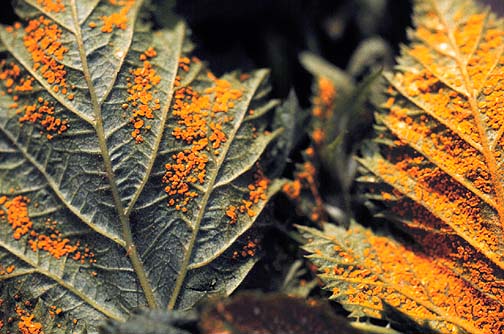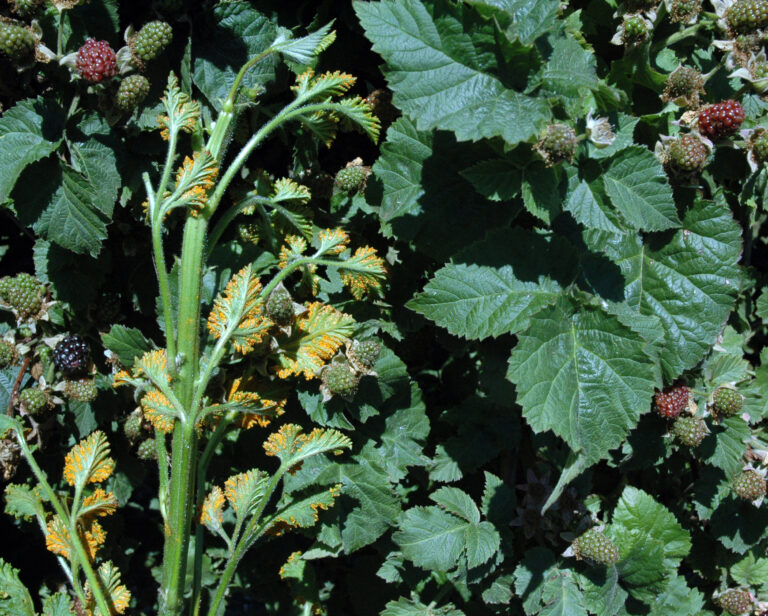
Jay W. Pscheidt, State Extension Plant Pathology Specialist Oregon State University l OSU Extension Service
A relatively new disease called Orange Rust has been spreading in Oregon blackberries. It is important that all blackberry growers are aware of the disease, scout for it and act if found. Confirmed new locations found this summer include Canby, Molalla and Stayton areas. Commercial growers in Benton, Clackamas and Marion counties have seen this disease but growers in other counties should beware.
Actions – Quickly remove and destroy infected plants including roots. There are no chemicals that will cure existing infection. Herbicides can be used as a spot treatment to kill infected plants. To kill infected blackberry plants when detected, cut the stems near the ground and treat them immediately with glyphosate (following directions on the label). Dig out the roots a week later. If treatment occurs in the spring, a follow-up treatment may be necessary. Best results occur when treated in summer to early fall (September). Fungicide registered for rust control can be used but only to prevent new infections.
Susceptible cultivars grown in the PNW include Black Diamond, Kotata, Lochness, loganberry and thimbleberry. Red raspberries are resistant while black raspberries are susceptible. Wild Himalayan blackberry also gets the disease and can be a source of spores for commercial fields. There is a lot of variation in the wild plants as they are not all affected in areas where the rust is found.
The systemic nature of this disease is what distinguishes it from the other rust fungi on blackberry. Infected floricanes never produce flowers or fruit. Primocanes are already infected and form spores soon after sprouting from the crown. Infected plants cut in May to limit spread will resprout in June with more spores.
Symptoms of this disease include many weak, spindly shoots that arise from infected roots and crowns in spring. Sometimes only one primocane may be infected, making the disease difficult to find. Infected shoots may lack thorns and resemble weeds or plants with herbicide injury. In spring, unfolding leaves can be stunted, misshapen, and pale green to yellow. Lower leaf surfaces become covered with blister-like pustules (aecia). Aecia are waxy at first, then turn a powdery bright, almost fluorescent orange. Once found it is obviously different from other rust diseases that occur on blackberries.
Because of its widespread occurrence it is unlikely that statewide eradication attempts would be successful.
Are you seeing this disease on your farm?
Has it expanded its hold on plants over the years?
Have you noticed additional symptoms subsiding after hot/dry weather conditions?
Questions? Email Jay Pscheidt or join the conversation here.
Jay W. Pscheidt, PhD, Professor
State Extension Plant Pathology Specialist
Oregon State University l OSU Extension Service
2621 Cordley Hall,
2701 SW Campus Way,
Corvallis, OR 97331
Voice: 541-737-5539 Cell: 541-740-6621 FAX: 541-737-2412



We have organized our mailing list to better serve our audience. Subscribe to receive exclusive updates from our weekly SFU newsletter or join our communications list for industry news, our events, forum alerts, and more. No spam. Just updates.
One Response
Dr. Pscheidt,
When I was clearing out Himalayan blackberries in my yard in Eugene recently, I found one that is infected with Blackberry Orange Rust. The rest of the blackberries looked healthy. I called Lane County Extension and was told that I could put the infected plant in a bag in my trash, and it was ok to put all the healthy ones in my yard debris trash bin. I just wanted to confirm that even though the infected plant had been piled with the healthy ones, that I can still put the healthy ones in the yard recycling bin. Lane County Extension said that the rust is dormant now and it won’t contaminate the healthy plants. Thank you, Karen Lawrence